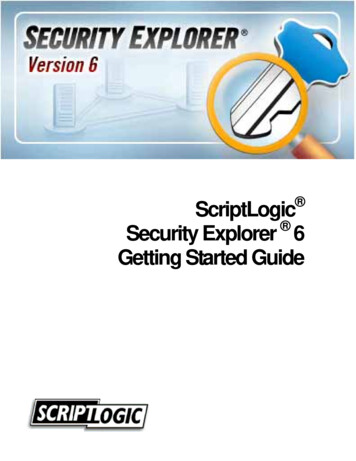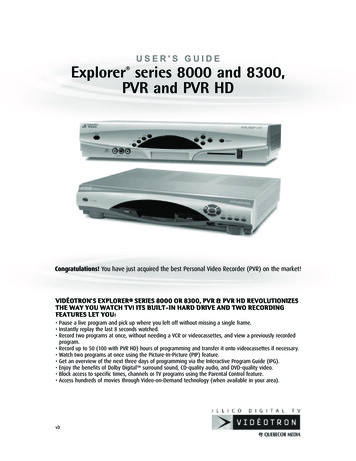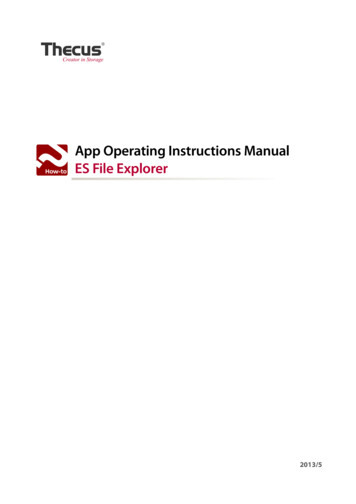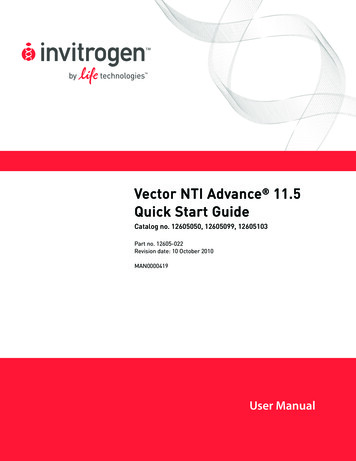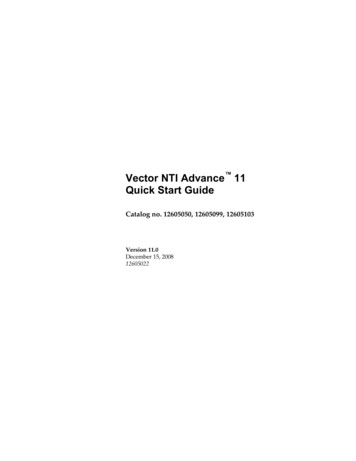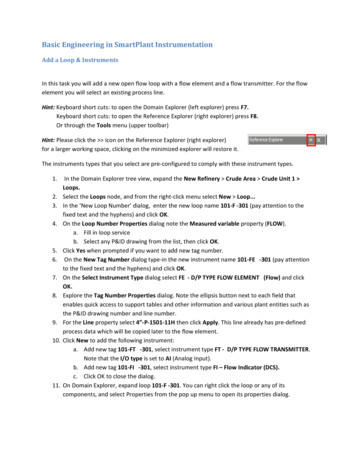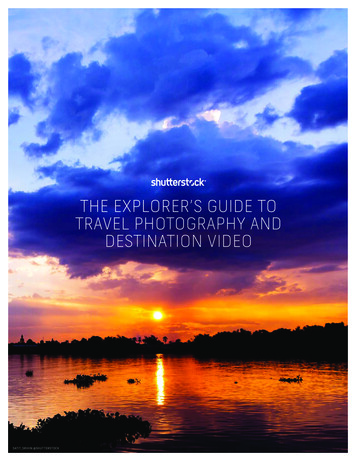
Transcription
THE EXPLORER’S GUIDE TOTRAVEL PHOTOGRAPHY ANDDESTINATION VIDEOS AT I T S R IHIN @ S HU T T E R S T OC K1
CHAPTER 1T R AV EL T IP S A ND R EG U L AT ION S — Tips and tricks for working abroad.From paperwork to personal safety, these are the things you need to know while packing your bags.VA L E N T Y N VOL KOV @ S HU T T E R S T OC K2
CHAPTER 1/1P lane s , Tr ain s , an d A u to m ob ile sPlanning to travel for a destination shoot? Well the first thingEvery airline is different, so it’s important to always check theyou need to do is figure out how to get there.rules. Never assume that you can bring anything onboardwith you.It’s exciting to plan a trip, until you have to go through thegrueling process of scheduling everything. From plane ticketsAny seasoned traveler will tell you to keep your camera gear withto rental cars, there are quite a few things to rememberyou at all times — and rightfully so. No matter how much gearwhen planning.you take with you, if your camera body gets lost in transport, youwon’t be able to shoot anything. As a good rule of thumb, alwaysAirports, Baggage, and Securityplan to carry on your camera body and lenses. That is also theWhen planning to travel by airplane, there are so many littlebest way to physically protect them from being tossed aroundthings that you have to remember for every trip. Once you havewith all the other baggage.booked a flight, you will need to check the airline’s regulationsfor carry-on bags, weight of checked bags, and their rules ontraveling with batteries.S AT I T S R IHIN @ S HU T T E R S T OC K3
The other things you always have to carry on are any lithiumNow that you know how many things you have to carry on withmetal and lithium-ion batteries. These are the rechargeableyou, check to see if all of that gear will fit in a carry-on bag. Mostbatteries you will need to operate your camera, lights, and evenairlines allow one carry-on bag and one personal bag. So you candrones. You also need to know the Watt hours (Wh) of eachstow your camera and lenses in an overhead compartment, whilebattery. Most airlines will allow you to carry on an unlimited (yetkeeping all your batteries in a backpack underneath your seat.reasonable) amount of batteries under 100Wh. For any batteriesover 100Wh, passengers are usually limited to two batteries.For larger gear, you may be able to carry it on depending on size,Combinations are often allowed, so many photographer andbut you’ll probably have to check things like tripods and lightvideographers will travel with two batteries over 100Wh and thestands. For these types of items, you’ll want to invest in a hardremaining batteries under 100Wh. For those traveling with filmshell case. That way your gear is protected from being dropped,stock, carry on film rolls as well. Checked baggage goes throughmishandled, or stacked upon.a stronger x-ray process that can damage your film stock.NGEL A A L A DRO MEL L A @ S HU T T ER S T OC K4
With all the gear packed up nice and tight, don’t forget that mostRental Cars vs. Taxisthings will have to come out of the bag when you go throughWhen you reach your destination, you should consider your ownsecurity. Airport security, like the TSA in the United States, havemeans of transportation, if that’s an option. A rental car is theseveral stipulations when it comes to getting into the terminals.best bet, since it allows you to manage your time schedule. IfYou may be familiar with removing your laptop from carry-onyou’re shooting the sunrise, you may have trouble finding a taxi.bags. Similarly, you should remove your batteries and placeIf you opt for a rental, be sure there is enough room in the trunkthem in their own x-ray container. This usually helps preventor backseat for all of your gear. You can never know if all yourthem from pulling your bag aside to physically inspect it. If yougear fits into a random taxi.are planning to use film, know that the scanners can fog yourunprocessed film stock. You can request security officers toWhen renting a car, be sure to know what the auto insurancehand-inspect your film, especially any film over 800 ISO.plan covers. You may find yourself off-road or even using thecar as a platform by standing on the hood or sitting on the roof.Make sure you have all your paperwork at hand and in order. YouKnow how any dings and dents will be handled. Another addedmay just need a passport, but work over an extended period ofbenefit of renting a car is the access to power. If you remembertime may require a work visa or permit. Another considerationyour car charger, you can keep your phone alive during the drive.is to travel with proof of previous purchase of equipment. Whenreturning home after shooting abroad, customs may ask you toverify that you had previously owned that camera of yours. Theywant to make sure you aren’t avoiding taxes and traveling to buycheaper equipment.RO S S HEL EN @ S HU T T ER S T OC K5
CHAPTER 1/2Re s e ar ch an d A c c o m m o d a tio n sWhether you are staying with friends or in a hotel room,Once you have a few key places in mind, learn how long it willhere are a few considerations for your location shoot.take you to get there from your hotel. Print out any maps anddirections — you never know if you will have a cell signal.Location, Location, LocationWhen it comes to working on location, you want to make sureAnother consideration is meals. If you’re not one to try the localyou stay somewhere central to all the places you want to visit.cuisine — or you don’t want to take any risks until shooting isIt makes little sense to book a luxury hotel hours away whendone — be sure to pack some snacks and non-perishable meals.you will be spending time in remote areas. Spend plenty of timeIf you are into local foods, check out reviews for any places thatresearching any location you may want to travel to and shoot.spark your interest.You can find plenty of resources and references online. See whatother photographers and videographers have captured in thoseDon’t forget to check the weather. Be prepared for thecities. If anything sparks your interest, be sure to hunt down thetemperature, humidity, rain, or snow.exact address or at least pinpoint an area.B OGDA N S ON J A C HN YJ @ S HU T T E R S T OC K6
P ack in g Your B a gEver y location has its own set of challenges. From weatherto the physical nature of the landscape, you need to packclothes that will keep you comfor table and safe.Much of your clothing will come down to personal tastes.To pack light, keep with neutral colors — that way ever y thingmatches. Be aware of cultures and customs, as tight clothingor skir ts may not be appropriate. Here are a few things youshould always pack. Rain Jacket (Doubles as a Camera Monitor Cover) Pockets (Shir ts, Shor ts, Pants) Quick Dr y Clothing Long Sleeve Shir t (For Warm and Cold Weather) Under wear (Athletic, Breathable) Closed Toe Shoes (Boots or Hiking Shoes) Wool Socks (Socks with padding) Hat (Rain, Sun, Baseball Cap)A F R IC A S T UDIO @ S HU T T E R S T OC K7
As mentioned, your destination will play a big role in theProtect Yourself and Your Gearspecific type of clothing you bring. A mountain range or trail-As you research your location, make sure you have an insuranceheavy location will require hiking boots. For beaches, lakes,policy in place that will protect you and all of your equipmentor swamps, you will want some water shoes or rain boots.Traveling without insurance is a risk not worth taking. ProtectDress appropriately.your gear from damage and theft with an insurance policy.Make sure your policy is in effect while abroad.On top of clothing, there are a few other items you will alwayswant to pack. Perhaps most important is a first aid kit. Even afew bandages and alcoholic wipes will help. You will also wantto protect yourself with sunscreen and bug spray. Be sure thebottles you get meet airline standards for travel if you plan tocarry on your bag. Don’t forget basic toiletries like a toothbrush,toothpaste, and even some toilet paper. You don’t want to beleft without toilet paper in the wilderness when nature calls.A NDR E A I Z ZO T T I @ S HU T T E R S T OC K8
CHAPTER 2C A MER A S, L EN S E S, A ND AC C E S S OR IE S — The cameras professional travelers use, the righttype of lenses, and all the gear and accessories you need for a successful shoot abroad.S T E FA NO G A R A U @ S HU T T E R S T OC K9
CHAPTER 2/1C A MER A SYour camera is a physical extension of yourself. When it comesThat said, here are a few of the most popular options from thetime to choose the perfect camera — there isn’t one camera forbiggest camera manufacturers. The cameras featured in this listevery shooter.shoot both stills and video.Traveling photographers and videographers have countlessoptions. Point-and-shoot, compact, DSLR, and mirrorlesscameras are all perfect for travel. There are even specialtycameras like underwater action cameras and drones.GE N JOK @ S HU T T E R S T OC K10
C anonPowerShot G16 (MSRP: 499 US)Compact Point-and-Shoot12.1 Megapixel CMOS Sensor28-140mm Lens EquivalentHD 1080p VideoPowerShot G7 X Mark II (MSRP: 699 US)Compact Point-and-Shoot20.1 Megapixel CMOS Sensor4.2x Optical Zoom Lens (24-100mm)HD 1080p Video up to 60fpsEOS Rebel T6i (Body Only MSRP: 749 US)Compact DSLRCanon EF Mount24.2 Megapixel CMOS SensorHD 1080p Video up to 30fps 720p up to 60fpsCanon EOS 5D Mark IV (Body Only MSRP: 3499 US)DSLRCanon EF Mount30.4 Megapixel Full-Frame CMOS sensor4K Video up to 30fpsHD 1080p Video up to 60fpsHD 720p Video up to 120fpsEOS 1D-X (Body Only MSRP: 5299 US)DSLRCanon EF Mount18.1 Megapixel Full-Frame CMOS sensorHD 1080p Video up to 30fpsHD 720p Video up to 60fpsA L L I A NC E @ S HU T T E R S T OC K11
N ikonCoolpix S7000 (MSRP: 279 US)Compact Point-and-Shoot16 MP CMOS SensorZoom-NIKKOR ED (25-500mm Equivalent)HD 1080p up to 30fpsCoolpix P900 (MSRP: 599 US)Compact Digital16 MP CMOS SensorZoom-NIKKOR ED (24-2000mm Equivalent)HD 1080p up to 60fpsDL24-500 (MSRP: 999 US)Compact Digital20.8 MegapixelNIKKOR 8.8-185mm f/2.8-5.6 ED VR Lens4K Video up to 30fpsHD 1080p up to 120fps, 720p up to 240fpsD7100 (Body Only MSRP: 1199, Now 799 US)DSLRNikon F Mount24.1 Megapixel DX CMOS SensorHD 1080i up to 60fpsHD 1080p up to 30fpsD810A (Body Only MSRP: 3799 US)DSLRNikon F Mount24.1 Megapixel F X CMOS SensorHD 1080i up to 60fps1080p up to 30fpsD5 (Body Only MSRP: 6499 US)DSLRNikon F Mount20.8 Megapixel F X CMOS Sensor4K up to 30fpsHD 1080p up to 60fpsE UGE NIO M A RONGIU @ S HU T T E R S T OC K12
S on yAlpha a6300 (Body Only MSRP: 999 US)Compact MirrorlessSony E Mount24.2 Megapixel Exmor CMOS Sensor4K up to 30fpsHD 1080p up to 120fpsAlpha a7S II (Body Only MSRP: 2999 US)MirrorlessSony E Mount12.2 Megapixel Full-Frame CMOS Sensor4K up to 30fpsHD 1080p up to 120fpsAlpha a7R II (Body Only MSRP: 3199 US)MirrorlessSony E Mount42.4 Megapixel Full-Frame CMOS Sensor4K up to 30fpsHD 1080p up to 120fpsS OF T L IGH T @ S HU T T ER S T OC K13
P an a s o nicLumix L X100 (MSRP: 799 US)Mirrorless24.3 Megapixel Micro 4/3 CMOS SensorLumix DC Vario Lens (24-75mm Equivalent)4K up to 30fpsHD 1080p up to 60fpsLumix DMC-GH4 (MSRP: 1499 US)MirrorlessMicro Four Thirds Mount16.05 Megapixel Micro 4/3 MOS Sensor4K up to 24fpsHD 1080p up to 60fpsFuji f ilmX-T2 (Body Only MSRP: 1599 US)MirrorlessFujifilm X Mount24.3 Megapixel Crop CMOS Sensor4K up to 30fpsHD 1080p up to 60fpsOlympusOM-D E-M1 (MSRP: 899 US)MirrorlessMicro Four Thirds Mount16.3 Megapixel MOS SensorHD 1080p up to 30fpsGoProHero4 Black (MSRP: 499 US)Action Camera12 Megapixel PhotosUltra-Wide Lens4K up to 30fpsHD 1080p up to 120fpsILYA OR E S HKOV @ S HU T T E R S T OC K14
CHAPTER 2/2L en s e sChoosing the right lens or lenses will come down to a few differ-Here is a breakdown of lens properties and some suggestionsent factors. You need to consider the type of mount your camerabased on the type of travel photography and video you mayuses, the style of shooting, the weight of the lens, its build quali-be shooting.ty, and overall lens speed.MINE R VA S T UDIO @ S HU T T E R S T OC K15
Focal LengthDepth of FieldThe most important information to know when looking for aThe depth of field is the area of an image that is in focus.camera lens is the focal length. Focal length tells a photographerThis focus range measures the distance between theor videographer how the image is going to look. The shorter thenearest and farthest objects.focal length, the wider the angle of view. The longer the focallength, the higher the magnification and narrower the angleLenses can precisely focus on one distance at a time. To haveof view.sharper images, a larger depth of field is needed. For imagesemphasizing a single subject over the background, a shallowdepth of field is needed.A R T G O @ S HU T T E R S T OC K16
F - StopT-StopThe f-stop is a numerical representation of lens aperture size inT-stops are used by filmmakers to precisely measure the exactrelation to the focal length. An f-stop will tell you how much lightamount of light entering a lens at any given f-stop. Combinedyour lens is letting in. Lower f-stop numbers (1.2, 1.4, 1.8, 2) willwith the f-stop, t-stops give a much more accurate number. Forlet in more light than a higher f-stop number (8, 11, 16, 22.)example, a 100mm lens at f/2 with a light transmittance of 75%will have a t-stop of 2.3.In photography and video, a stop is a step that can either doublethe incoming light or cut the incoming light in half. StoppingCrop Factordown is the equivalent of moving from a lower number like 2.8Not to be confused with a 35mm lens, crop factor deals with theto a higher number like 4. Stopping up moves from a highersize of a camera’s sensor. A full-frame sensor is 35mm, thoughnumber down.technically the size is 36mm x 24mm. It comes from 35mm film,which required a 35mm sensor to capture full-size images onLenses with the same f-stop do not necessarily let in the samethe film stock.amount of light. The glass elements within the lens affect thetotal amount of light let into the camera. More expensive lensesAny camera with a sensor smaller than 35mm wide is a croppedwill allow more light in versus cheaper lenses. A professional lenssensor. Regarding lenses, this will make a lens appear to be moremay allow in 90% of light, where as a consumer model may onlyof a telephoto lens. For example, a 100mm lens with a cropallow in 60% of light.factor of 1.6x will act like a 160mm lens on a full-frame camera.NORG A L @ S HU T T E R S T OC K17
L en s S t ab ili z a tio nMost lens manufacturers use a form of lens stabilization whichcompensates for camera movement when taking a photo orshooting video. The system uses electromagnets to moveinternal glass elements.The magnets act like a spring suspension that absorb camerashake. You might be familiar with these types:Canon – Image Stabilization (IS)Nikon – Vibration Reduction (VR)Sigma - Optical Stabilization (OS)Tamron – Vibration Compensation (VC)Leica – MegaOISPentax – Shake Reduction (SR)The downside of lens stabilization is the added cost, as thesetypes of lenses can cost double the amount of the same lenswithout stabilization. Also, if you are using the camera and lenswith a tripod, it is best to turn off the lens stabilization. Thisprevents the lens from overcompensating and wearing outthe system.V EC T OR F U S ION A R T @ S HU T T E R S T OC K18
Ty p e s o f L en s e sWide-Angle LensesPrime Lenses and Zoom LensesA wide-angle lens has a focal length of 35mm or smaller.Lenses that have a fixed focal length, meaning the focalLenses smaller than 24mm may also be called ultra-wide lenseslength cannot be changed, are prime lenses. Lenses with anor fisheye lenses. Due to size exaggeration, wide-angle lensesadjustable focus length are called zoom lenses. Zoom lensesare great for shooting landscapes and architecture.have a multitude of moving parts, limiting the amount of lightthey let in. However, they give the shooter more control of theTelephoto Lensescomposition based on their position. Prime lenses require theTelephoto lenses have a focal length of 85mm or higher. Theyshooter to physically get closer or farther away from a subject.are usually very long in length, making them easy to identify.Travelers often find zooms to be more practical.Telephoto lenses are used to shoot objects that are far away,ideal for capturing wildlife and sporting events. They blur theLenses for Travelersbackground, making them ideal for isolating subjects.Every traveler has their own preference for both the type oflenses they use, as well has how many they take with them.Telephoto lenses have more glass elements, making them moreSome may prefer only to carry one versatile lens, but mostexpensive. They can be broken down into two subtypes. Mediumaverage three lenses.telephoto lenses have a focal length of 85-300mm and supertelephoto have focal lengths over 300mm.Here are some of the most recommended lens optionsbased on popular types of travel photography and destinationStandard Lensesvideo. Remember to take the crop factor into account onStandard lenses have a focal length between 35mm and 85mm.cropped sensors.The most commonly used standard lenses are the 35mm and50mm. Standard lenses usually have a much cheaper baseprice than wide-angle and telephoto lenses. Standard lensesare perfect for shooting portraits and medium shots.A R S L A A N @ S HU T T E R S T OC K19
G ener al P ur p o s e Tr avelIf you want to only carr y one lens, or as few as possible, a generalpurpose lens is ideal for capturing ever y thing from por traits tolandscapes. General travel photography and video will either needto have a large zoom range with little weight, or an all purposeprime lens.15-85mmVersatile Zoom LensStandard for Ever yday PhotographyDesigned for Cropped Sensors24-70mmWide-Angle to Medium TelephotoPopular Among ProfessionalsVer y Sharp Images50mmVersatile Focal LengthCompact and LightweightPerfect from Por traits to Action ShotsStellar in Low LightK I T C HO W @ S HU T T ER S T OC K20
P o r tr ai t s an d C ul tur eIf your travel photos and videos focus on people and theirculture, you will want a lens that can really capture intimatemoments. Lenses with aper tures of f/1.8-f/3.5 are great forpor traits witha subject in focus and a blurred background.16-35mmPopular Among PhotojournalistsGreat for Group ShotsSimilar Angle of View to Cell Phones85mmGreat for Interiors and ExteriorsIdeal for Por traits on Full-Frame SensorsGreat Telephoto Lens for Crop-Sensor CamerasS PA S S @ S HU T T ER S T OC K21
L and s c ape sWide-angle lenses are the best for landscape travel photographyand video. Lens aper tures of f/5.6 and above will help keepever y thing in focus.16-35mmUltra Wide-Angle ZoomAmazing for Landscapes and Por traitsExpensive17-40mmWide-Angle Zoom on Full-Frame SensorStandard Zoom on Cropped-SensorSimilar to the 16-35mmSharp Details18-35mmExcellent for Landscapes and ArchitectureVersatile Wide-Angle to Standard ZoomSimilar to the 16-35, and Cheaper10-24mmUltra Wide-Angle ZoomGreat for Landscapes, Cityscapes, and Interiors24mmWide-Angle PrimeExcellent for Low Light and AstrophotographyC R I S T OB A L G A RC I A F E R RO @ S HU T T E R S T OC K22
W ildli f eTelephoto lenses are a must for capturing wildlife. Thatsaid, these lenses are the heaviest. A zoom lens offersmore variety while traveling, yet fixed super-telephotolenses may be necessar y depending on the distance toyour subjectand the subject’s size - birds vs. elephants.70-200mmFantastic for Photos and VideoAcclaimed by Pros and HobbyistsPerfect for Wildlife and Por traitsHeav y and Expensive200-500mmWonderful for Wildlife, Especially BirdsGreat for Distant LandmarksLarge and Heav y600mmDesigned for Wildlife and Spor tsVer y ExpensiveVer y LargeVer y Heav yJ A C K5 3 @ S HU T T ER S T OC K23
T imelap s eTimelapse photography requires a wide lens with a deep depthof field. For those shooting days, nights, and day to night, youwill need a lens that can perform at ever y time of day.14mmUltra Wide-AngleStellar for LandscapePerfect for Nighttime Shoots16mmUltra Wide-AngleSmall and LightGreat for Landscapes and ArchitectureM A NF R EDX Y @ S HU T T ER S T OC K24
CHAPTER 2/3G e ar and A c c e s s o r ie sYour best resource is your own research of the locations. YouShooting abroad poses one of the biggest challenges formay find that some places, like major cities, have plenty of rentalphotographers and videographers alike. How much gear is thehouses for you to rent additional gear, like specialty lenses or bigright gear? From extra baggage fees to misplaced luggage,gear like tripods. Renting can save you the hassle of packing allthere are plenty of valid concerns.your gear.If you don’t have the luxury of renting, choosing the right gearshould be a priority.K E K YA LYAY NE N @ S HU T T E R S T OC K25
Batteries and PowerTo operate your camera, you’re going to need power. DependingMake sure you purchase the appropriate speed of card for youron your location, you may not have access to electricity whilecamera, as that will help you capture the best quality imagesshooting. Be sure you have enough batteries to keep you out inas quickly as possible. Don’t forget to pack any cables you maythe field long enough to capture what you need. The camera isn’tneed to dump and backup your photos and video.the only thing that needs batteries. Don’t forget AA, AAA, 9V, orany other type of battery you may need to operate equipmentTripods, Monopods, and Stabilizationlike lights. It’s also recommended to carry a battery pack so youHaving stable images and footage is crucial to a successfulcan recharge your phone while on location. Remember to be suretravel shoot. You will want to find gear that is as light as possible.to pack your batteries appropriately, as previously mentioned.Carrying heavy sticks over a long period of time will really wearIn addition to batteries, it’s always good to have some surgeyou down and hurt your back. Compact gear should be a priority.protectors and an extension cord to add a few outlets to yourhotel room. Don’t forget power adapters for the various typesMonopods are the easiest form of stabilization to travel with.of outlets around the world. Make sure you have one that worksThey are incredibly compact, and even some of the more ruggedin the country or countries you are headed to. If you will spendones are still rather lightweight. A carbon fiber monopod maysignificant time in a car, pack a car charger as well.cost more upfront, but they are well worth the price.Memory CardsTripods are the standard form of stabilization for photographersNow that you have a camera, lens, and batteries, you’re certainlyand videographers. There are a ton of different options, andgoing to need plenty of memory.there is a whole market for traveling shooters. You can findcompact tripods that collapse to an incredibly small size. ThereIf you plan to shoot a ton of material, your first thought may beare a variety of heads, from traditional mounts to pistol gripto purchase one very large SD or CF card. While that may seempivot heads. Tripods with pivoting heads tend to be the best forlike an easy solution, it’s actually best to have multiple smallertravel since they can offer level images no matter how ruggedcards. That way if something happens on location —the terrain. There are also travel tripods that have additionallike dropping your camera into the water — then you will stillfeatures like built in flashlights.have all the photos and footage you shot on the other memorycards that didn’t end up taking a dive.PAW E L PA JOR @ S HU T T E R S T OC K26
When it comes to choosing the right tripod, your main concernsHigh-end video lights and light wands have the ability to changeshould be the weight, size when collapsed, tallest height whentheir color temperature. This is great for all sorts of shoots. Youextended, and that the tripod can support the weight of yourcan use them to light subjects or adjust the colors and use themcamera and lens package.as backdrop lights.Videographers may want more options when it comes toA collapsible reflector is really the best lighting tool for travelingstabilization. There are travel shoulder-rigs built for a varietyphotographers and videographers. Most travel shoots will useof cameras, as well as traditional stabilizers like a Steadicam.a ton of natural lighting, and a reflector give you the power toWith traveling, weight should be a primary concern, as well asharness the sun. Collapsible reflectors can fit into small pouches,the size of the rig when collapsed. The smaller the better, butand many come with a variety of color options. The closer theremember that a variety of small parts means the potential forreflector is to your subject, the more powerful the light.pieces to get lost in the shuffle. You may also need a set of toolsto put the rig together, depending on the type of stabilizerAdditionally, a traditional flashlight or headlamp can alwaysyou choose.help light up a subject. Many flashlights have a very harsh light,so make sure you test the look of the flashlight ahead of time.Lights, Flashes, and ReflectorsThese tools are also helpful when digging through your gearPhotographers will be quick to find that traveling with a videobag in the dark.light is usually much more practical than carrying a camera flash.That’s not to say camera flashes can’t be the go-to for lightingND Filtersyour travel photos, but the video light also doubles as aNo matter if you are shooting stills or footage, you will wantflashlight and can be used in combination with reflectors to helpto make sure you have some neutral-density filters. Shootingcapture stunning images.outdoors in the middle of the day can be a nightmare for anyone,but an ND filter can help you capture excellent images in brightVideo lights are compact, and you can easily find them at a veryconditions. With an ND filter and the correct combination oflow cost. This is great for travel, so if something does happenaperture and exposure settings, your camera can grab stillsto your light, it’s easy to replace. Many video lights can useand video that would otherwise be overexposed.rechargeable batteries, or even AA batteries.Graduating ND filters, or split ND filters, can be used to balancethe light, especially at sunrise and sunset. They can darken abright sky, while leaving the landscape naturally lit.A NGEL PA R DA L @ S HU T T ER S T OC K27
Variable ND filters offer multiple stops of light control, all in oneBe sure to pack the necessary tools to take your gear apart iffilter. You can easily adjust the ND filter to whatever you need foryou have to do heavy cleaning or assemble any camera rigs.the shot. If you invest in a nice variable ND filter, you may wantInvest in a quality multitool, not one that will easily break. A steelto add a step-up ring. That will allow you to use the filter on allmultitool with built-in screwdrivers, pliers, and knives are oftenof your lenses, no matter the lens diameter size.the best.Microphones and Audio RecordersDon’t forget any allen wrenches or specialty tools you may needVideographers will need to remember microphones or audiofor specific gear. Zip ties are also great to have. Keep all yourrecorders to capture audio on location. From the ambient soundstools in an easy to grab pouch, so you know where everythingof an oasis to capturing interviews, quality audio is crucial tois. Don’t forget that tools may need to be placed in yourevery video.checked bags.For travelers, the best option is a handheld audio recorder andLaptops and External Hard Drivesa lavalier mic. Both are small and easy to transport. You can useWorking on location is usually much more than just shooting.the hand recorder to capture ambient sounds, and then plug theTo dump and check your photos and footage, don’t forget tolavalier mic directly into it for interviews. It’s the simplest andbring your laptop. It’s also recommended to store your files onmost travel-friendly setup.external hard drives as additional backups.Depending on the type of lavalier mic you own, don’t forgetCreate a solid folder structure for your project, so files are easyaudio cables and adapters if needed. Wireless lavs can be ato find when it comes time to edit. You can break your travelhassle on remote locations, so consider going hardwired intophotos and video into individual folders based on the day youthe recorder.shoot or on specific locations.Cleaning Kit and ToolsBacking up your folders on an external hard drive is highlyFrom microfiber wipes to a dust blower, investing in a portablesuggested. Opt for a Solid State Drive (SSD) to store your imagescleaning kit can save your shoot. Dust, dirt, and all the naturaland footage. They have faster read/write speeds and are moreelements will wreak havoc on your gear. Make sure you can easilydurable. Upon your return, don’t forget that Shutterstock wouldclean your lenses while on the go.love to see contributor submissions.JOHN G OME Z @ S HU T T E R S T OC K28
Backpacks, Cases, and Carry-OnsCamera backpacks are perfect for travelers, and they come in aNow that you have a rough idea of all the camera gear you needvariety of sizes. There are small bags for those with just a camerato travel with, it’s time to find the right bags for your traveland a couple lenses, and there are heavy-duty backpacks thatshoot. The perfect bag is the one that is perfect for you.can carry several camera bodies, lenses, and gear. You can evenclip on additional gear outside of large bags, like your tripod.Rolling bags will only be your friend in the airport. OversizeThese backpacks are designed to keep you moving, so look forrolling bags and hard-shell cases will keep you gear safe ina bag that distributes weight evenly and has nice sturdy stra
THE EXPLORER’S GUIDE TO TRAVEL PHOTOGRAPHY AND DESTINATION VIDEO SATIT_SRIHIN @SHUTTERSTOCK. TRAVEL TIPS AND REGULATIONS — Tips and tricks for working abroad. From paperwork to personal safety, these are the t

